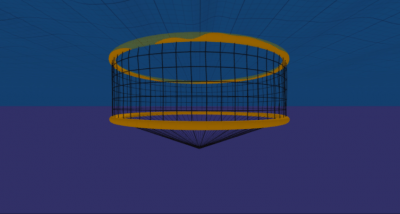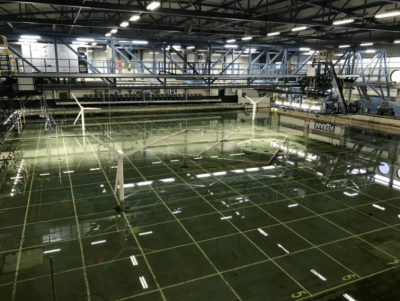Assisting the fishing industry
Our seas and oceans are a breeding ground for an abundance of high protein food: fish. Fish requires three to eight times less valuable nutrients per kilogramme of food when compared to land mammals. Therefore, fish – if managed prudently – can be considered an important sustainable food resource to feed the increasing world population, while keeping our carbon footprint limited.
Fish can be cultivated in fish farms or caught at sea, with both methods requiring large, flexible net (supporting) structures. These net structures are exposed to strong current and wave loads near the water surface. At the same time, the net structures have to be robust to ensure safe and clean oceans. MARIN assists its clients by determining the hydrodynamic loads and associated deformations and structural loads of these flexible nets and their supporting constructions.
Hydro-elastic numerical model of a fish farm
Our time domain, motion analysis solver aNySIM-xmf is suitable to calculate the coupled motion response of large floating objects such as floating islands, solar panel fields and floating bridges, but also underwater net structures. Hydrodynamic loads on the nets are included through an interactive coupling with our CFD codes. CFD provides the drag loads on the nets, while the motion analysis solver determines the hydro-elastic motion response. The coupled numerical models enable the loads on and motion behaviour of fish farm constructions to be determined. Furthermore, it can represent and help design regular commercial fishing nets.
Measurements of net structures at full scale and model scale are an essential addition to numerical modelling. These measurements reveal the complexity of the hydrodynamic loads and the motion behaviour of the nets and provide valuable insights, validation for numerical models, as well as demonstrating the feasibility of complex net constructions.
In addition to the abovementioned applications, MARIN also contributes to passive fishing techniques such as those found at offshore wind parks. Furthermore, we assist in the design process for fishing and support vessels and can perform optimisation studies for the hull and operational profile. We also evaluate low emission propulsion systems, manoeuvrability aspects and carry out on board measurements to define the performance of the vessel and fishing gear.
MARIN is proud to play a role in assisting existing and new clients in the fishing and aquaculture sectors in their drive for sustainable aquatic food production and the sustainable use of our blue oceans.



